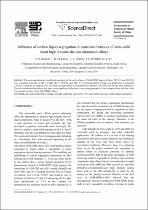 ResearchSpace
ResearchSpace
Influence of surface liquid segregation on corrosion behavior of semi-solid metal high pressure die cast aluminium alloys
JavaScript is disabled for your browser. Some features of this site may not work without it.
- ResearchSpace
- →
- Research Publications/Outputs
- →
- Journal Articles
- →
- View Item
| dc.contributor.author |
Masuku, EP

|
|
| dc.contributor.author |
Moller, H

|
|
| dc.contributor.author |
Curle, UA

|
|
| dc.contributor.author |
Pistorius, PC

|
|
| dc.contributor.author |
Li, W

|
|
| dc.date.accessioned | 2010-09-28T10:28:48Z | |
| dc.date.available | 2010-09-28T10:28:48Z | |
| dc.date.issued | 2010-09 | |
| dc.identifier.citation | Masuku, EP, Moller, H, Curle, UA et al. 2010. Influence of surface liquid segregation on corrosion behavior of semi-solid metal high pressure die cast aluminium alloys. Transactions of Nonferrous Metals Society of China, Vol. 20(3), pp s837-s841 | en |
| dc.identifier.uri | http://hdl.handle.net/10204/4376 | |
| dc.description | Copyright: 1997-2008 Editorial office of Transactions of Nonferrous Metals Society of China | en |
| dc.description.abstract | The aim of SSM forming is to obtain a semi-solid structure (which is free of dendrites) with the solid present in a near spherical form. The nature of the SSM slurry (with solid spherical grains suspended in a liquid), makes it susceptible to liquid segregation during forming processes such as high pressure die casting (HPDC). Surface liquid segregation appears to be a characteristic of SSM forming - the degree of segregation is dependent on alloy composition, die design and processing parameters. One of the major advantages of SSM processing is that high strength wrought alloys such as 7075 and 2024 can be used to produce near-net shape products. Corrosion is a surface phenomenon, and since the surface compositions of the SSM-processed components and wrought components differ greatly, their corrosion properties are expected to differ. The purpose of this paper is to compare the corrosion behaviour (in chloride medium) of the surface layer of SSM-HPDC plates of alloy 7075-T6 and 2024-T6 with the wrought alloys 7075-T6 and 2024-T6. Potentiodynamic testing was performed in deaerated 3.5%NaCl solution. In separate tests, the open-circuit potential was monitored in aerated 3.5% NaCl for 30 minutes after immersion. The electrochemical tests show no significant difference in the pitting potential of the wrought alloys and that of the Cu-enriched surfaces of the SSM-HPDC alloys. | en |
| dc.language.iso | en | en |
| dc.publisher | Editorial office of Transactions of Nonferrous Metals Society of China | en |
| dc.subject | Semi-solid metal | en |
| dc.subject | Wrought aluminium alloys | en |
| dc.subject | Alloy 7075 | en |
| dc.subject | Alloy 2024 | en |
| dc.subject | Corrosion | en |
| dc.subject | Surface liquid segregation | en |
| dc.subject | Nonferrous metals | en |
| dc.title | Influence of surface liquid segregation on corrosion behavior of semi-solid metal high pressure die cast aluminium alloys | en |
| dc.type | Article | en |
| dc.identifier.apacitation | Masuku, E., Moller, H., Curle, U., Pistorius, P., & Li, W. (2010). Influence of surface liquid segregation on corrosion behavior of semi-solid metal high pressure die cast aluminium alloys. http://hdl.handle.net/10204/4376 | en_ZA |
| dc.identifier.chicagocitation | Masuku, EP, H Moller, UA Curle, PC Pistorius, and W Li "Influence of surface liquid segregation on corrosion behavior of semi-solid metal high pressure die cast aluminium alloys." (2010) http://hdl.handle.net/10204/4376 | en_ZA |
| dc.identifier.vancouvercitation | Masuku E, Moller H, Curle U, Pistorius P, Li W. Influence of surface liquid segregation on corrosion behavior of semi-solid metal high pressure die cast aluminium alloys. 2010; http://hdl.handle.net/10204/4376. | en_ZA |
| dc.identifier.ris | TY - Article AU - Masuku, EP AU - Moller, H AU - Curle, UA AU - Pistorius, PC AU - Li, W AB - The aim of SSM forming is to obtain a semi-solid structure (which is free of dendrites) with the solid present in a near spherical form. The nature of the SSM slurry (with solid spherical grains suspended in a liquid), makes it susceptible to liquid segregation during forming processes such as high pressure die casting (HPDC). Surface liquid segregation appears to be a characteristic of SSM forming - the degree of segregation is dependent on alloy composition, die design and processing parameters. One of the major advantages of SSM processing is that high strength wrought alloys such as 7075 and 2024 can be used to produce near-net shape products. Corrosion is a surface phenomenon, and since the surface compositions of the SSM-processed components and wrought components differ greatly, their corrosion properties are expected to differ. The purpose of this paper is to compare the corrosion behaviour (in chloride medium) of the surface layer of SSM-HPDC plates of alloy 7075-T6 and 2024-T6 with the wrought alloys 7075-T6 and 2024-T6. Potentiodynamic testing was performed in deaerated 3.5%NaCl solution. In separate tests, the open-circuit potential was monitored in aerated 3.5% NaCl for 30 minutes after immersion. The electrochemical tests show no significant difference in the pitting potential of the wrought alloys and that of the Cu-enriched surfaces of the SSM-HPDC alloys. DA - 2010-09 DB - ResearchSpace DP - CSIR KW - Semi-solid metal KW - Wrought aluminium alloys KW - Alloy 7075 KW - Alloy 2024 KW - Corrosion KW - Surface liquid segregation KW - Nonferrous metals LK - https://researchspace.csir.co.za PY - 2010 T1 - Influence of surface liquid segregation on corrosion behavior of semi-solid metal high pressure die cast aluminium alloys TI - Influence of surface liquid segregation on corrosion behavior of semi-solid metal high pressure die cast aluminium alloys UR - http://hdl.handle.net/10204/4376 ER - | en_ZA |





